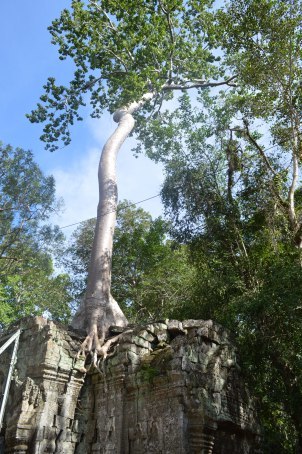Cambodia: Old and New
Forget everything you think you know about Cambodia. Vietnam War collateral, the “Killing Fields” genocide, a 3rd-world country of jungle and swamp. Cambodia is the place Captain Willard took a patrol boat upriver to hunt for the mad Colonel Kurtz in the 1979 movie Apocalypse Now. These were the images of the place I had in my head, but what I discovered was unexpected.
Most people know the country as the land where Angelina Jolie made the action flick Tomb Raider set around the ruins of Angkor Wat. And seeing the 1000-year old temples is one of the best reasons to visit Cambodia. The ruins located in Siem Reap pull in about a million visitors a year. You can spend a few days looking over stone carvings telling the tale of one of the world’s great civilizations and strolling through the ancient walls gripped by roots of “octopus” trees. Long ago reclaimed by the jungle, the time-worn structures look more like something of nature than something man-made.

For $30 the wife and I hire a car for the day to take us around. Everyone wants US cash. We could have hired a tuk-tuk, or motorcycle-powered carriage, but we need a/c. Even in September the thick jungle heat is like carrying around 30lbs of extra weight. Our drivers name is Trah and he starts telling us about Cambodian history as we head into a jungle with trees that towers over us.
Trah says there might have been 8 million people in the Khmer Empire at its peak. This is hard to imagine given how swampy the area is. But the Khmers were experts with water. The Angkor Wat temple has a giant moat or lake surrounding it. This looks like it was for defensive purposes, but it’s actually to keep the water-level stable so the temple doesn’t sink into the soft earth.

An “Octopus” Tree
After buying tourist tickets ($20 a person), Trah complains about the government. Somewhere in the capital there are protests underway against Cambodia’s prime minister. I had read about it in a newspaper in our hotel lobby. When Trah says the prime minister is corrupt, I laugh and say it sounds like every other country.
Trah parks the car across from a line of tent shops. We pass silk dresses and post cards and coconut bowls inlayed with mother of pearl. At the main temple entrance a guard asks to see our tickets. We spend a good two hours walking around the main complex.
As we’re leaving I ask Trah about himself. He says he’s thirty, married, has one son, owns one cow. The car he drives is rented. He says the reason he can’t afford his own car is because he doesn’t own land. He says there are many poor people that the taxes should be helping.
I think his attitude is interesting. I’ve seen poor countries, really poor with institutionalized poverty that’s all but inescapable. In these places the poor don’t talk like Trah, they don’t complain, they just try to get what they can.
Cambodia is a constitutional democracy and I think it’s a healthy sign when people can complain about the government. Recently they started experimenting with capitalism and free markets. They’ve opened up with liberal regulations for investors. Looking around the streets, you see the results. The children playing around their family’s snack cart all look healthy. The roads are filled with new cars – Toyota, Ford, Lexus. There are construction cranes working. Yes, you see poor people, but you also see something else – a middle class. This makes me think that Cambodia is on its way up.
In Siem Reap, you can get a 4 or 5-star hotel for $80/night. At our hotel, there’s a pool and spa and free breakfast. The hotel has meeting rooms and I walk past one being used. Inside are about fifty well-dressed business people learning about FX, or foreign exchange trading – advanced banking.
Later, at the hotel bar we meet Chamrouk. He’s been working at the hotel for five years and recently switched over from working in the kitchen. He’s only been a bartender for two months and uses a notebook for making mixed drinks. Chamrouk says that 70% of Cambodians work in agriculture, which was where America was back in the 1840’s.

The bartender and his drink notes
I ask Chamrouk where most of the tourist come from. He says China, Korea, Japan, Australia. His hotel is doing well. They have a yearly employee party with giveaways. Chamrouk is happy to say he won some money at the last one.
The next day, while walking around, I buy a magnet off a young boy selling to the tourists. I negotiate a lower price and the young boy complains, stomping his feet and whining, playfully overacting in his salesmanship. If he was desperate for money, he would take my lower price, but he’s not.

The Mekong River flowing past Phnom Penh
Cambodia is not just some old idea of Indochina. There’s change in the air. The friendly people are not looking to just survive, they’re looking to thrive. The country feels like it’s in the process of shifting into a higher gear of economics and freedom, which makes it a great time to go there and see the history as well as get introduced to the people.





